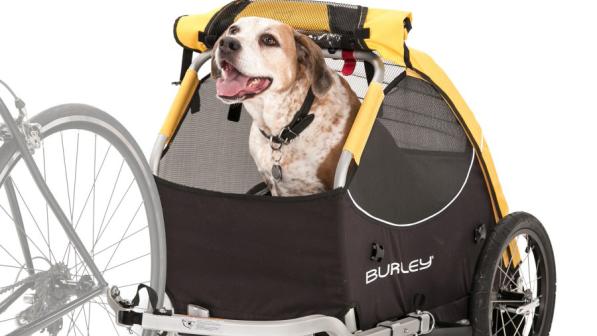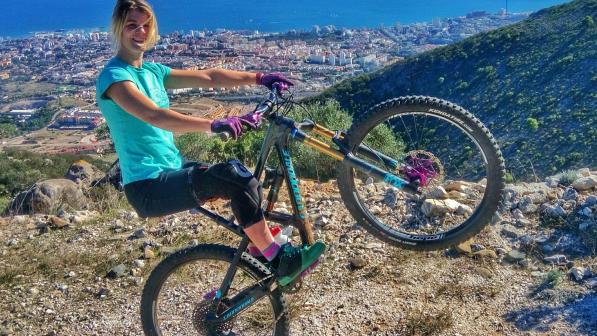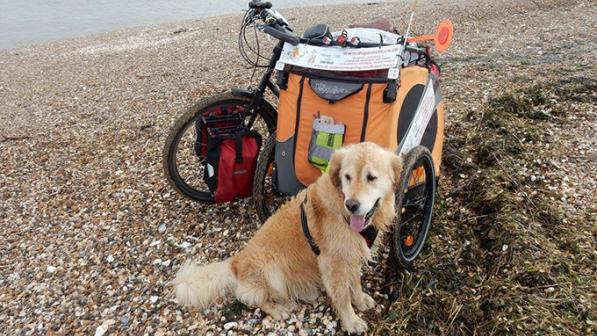How to train your dog to enjoy the trails

Claire Martin, a dog trainer and behaviourist, and canicross, scooter and bikejoring competitor, lives with 10 dogs. Five are rescued Spanish podencos/podenco crosses and the other five are sighthound rescue dogs from the UK and Ireland. All run off lead alongside her or in harness while she runs, scoots, or bikes – so they have to be both trail dogs and sled-dogs.
Is your companion suitable for life as a trail dog?
Choosing a dog to run trails with you needs a few considerations: “The breed should have the physical ability to run at the pace you want to travel, and in the conditions you want to ride trails,” Claire explains.
“Avoid dogs with flat faces, overly long backs and short legs. Don’t choose a husky if you want to ride with your dog in the summer in Spain, but equally don’t go for a saluki to accompany you on frozen alpine trails in February!”
There are hundreds of breeds which could suit as your companion, but Claire says to consider how they will fit into your lifestyle for the other 23 hours in a day.
Starting out
“If you want a puppy, then for the first nine months to a year, intensity of exercise needs to be considered. Too much too soon isn’t good for growing bones. The larger the dog, the longer they take to fully mature.
“However, puppy phase is a valuable time to teach your dog where you want them to run. Many like their dogs to run behind them. For me, that isn’t where I want them, as I want to see where they are and also have them run ahead of me in harness.”
Claire stresses that it’s essential that you train your dog not to be afraid of a bike, which is best done with food: “When your puppy goes for a walk, have it on a lead in one hand and your bike rolling along beside you in the other hand. Gradually get it used to the noise of brakes and the sound of the chain moving through the gears.
“Start to scoot on your bike while holding the lead and for every change you make, reward your dog. Soon, just your hands on your bike will signal to it that great things are about to happen.”
She emphasises the importance of training adopted adult dogs in the same way you would a puppy: “If you choose to adopt an adult dog, then start training it just like it was a puppy. Be patient, and use food and play as a reward as frequently as possible – the more you reward, the more the dog will obey.”
“Training your dog not to stop on a trail is tricky and is best done by training a fast ‘heel’ type position. I do this by throwing treats to the side of me and ahead while I ride steadily, so my dog gets rewarded for being beside and ahead of me. If you want it to follow you, the treats need to be thrown behind you.
“When your dog gets the treat, use the word you want to use to cue that behaviour – so for me the word might be ‘side’.”

Claire explains that dogs may not always want to run trails, and that it’s important to strike that balance. “Sometimes they want a slower, sniffy walk, and other times they want to go to the beach, so don’t forget that variety makes for a happy dog.”
When it comes to the type of trails which are best for dogs, Claire suggests grassy and muddy ones. "Rocky, especially flinty, trails are as tough on paws as they are on tyres, so good paw health is important. Keep nails short and check your dog’s pads for abrasions.
“There are boots to protect dogs’ paws, but these are no substitute for gradually building up the miles under their paws and even some massaging with paw balm.”
Water is essential. Unlike us, dogs can’t sweat. They lose heat by panting, and through their paws. Riding trails with plenty of natural water to supply your trail dog with liquid refreshment is so important.
“If it’s dry out, carry water for them, too. Dogs are also wearing a fur coat. Regular brushing will help to remove dead hair and help the coat to regulate your dog’s temperature, but dogs overheat at temperatures much lower than we do – so fitness, low body weight and, most importantly, awareness of signs and symptoms of your dog overheating are very important.”
Keeping your dog safe and healthy
Claire recommends: “Dogs of almost every breed should be slim. Ideally you should be able to feel their ribs easily. If it feels like there is a sheet or a blanket over their ribs, that’s OK. If it feels like they are wearing a duvet then they are carrying too much fat, and as a result won’t be as fast, happy, healthy and long living.”
“Make sure that you feed your dog a healthy, balanced diet, but just like us, it’s totally fine to have a snack out on the trail. There’s nothing nicer than sharing a snack with your best friend, but do make sure that your snack doesn’t contain anything that could harm your dog.”
There are risks involved when trail riding with your dog. Accidents happen with us too, but there isn’t a 999 equivalent for dogs, so it’s important to have a plan just in case.
Claire advises: “If you’re riding near roads, then ensure you have a lead for your dog, and slow down to keep your dog away from traffic. If you are near livestock, then the same rules apply – even riding beside a flock of pregnant ewes with a dog that scares them can cause them to abort, so again, put your dog on their lead and go slowly past livestock.
“I also use a GPS tracker on my dogs in areas where they might be tempted to wander. Even the best-trained dog can be temporarily distracted by a deer, rabbit or squirrel, and the tracker is a great emergency back-up. It also tracks how far my dog runs, and the data on your dog’s speed and distance travelled is fascinating.
“I carry the bare essentials of a first aid kit for both me and my dog, and have considerably more medical supplies in my van.”
When age catches up with your dog, it’s important to consider taking slower rides because being beside you on your bike will still be important to them. Claire’s 13-year-old dog still likes to run out with her, but only in kind weather, on flat soft trails, and for maybe just a couple of miles at most.
Claire's top tip? Have fun: “There is never a reason to use punishment, aversive tools or harshness in your training. Your dog will build a much stronger bond with you through kindness and play.”
Anna and Dogga

I live in Spain and had never owned a pet before I adopted Dogga, with my bike-mad husband. Dogga is a podenco – an agile, fast dog, bred in southern Spain for hunting. She is medium height, with short hair, ridiculously huge ears, and a colour perfectly camouflaged amid the dry, arid landscape.
Her breed makes her extremely timid, so in order to get her used to the bikes, we leaned them up against the wall and put her bed underneath, allowing her to sniff them and feel comfortable around them.
I wanted her to be a trail dog straightaway, but I had to start with the basics. ‘Sit’, ‘come’ and ‘heel’ were the recommended commands, as well as teaching her to go to the toilet outside of the flat, and not to pull on the lead.
I was careful not to let her run long distances as it doesn’t do dogs’ joints any good. Each breed is different, but a general rule of thumb I stuck to is five minutes of running on hard ground for every month that they’ve been alive.
She’s not the most obedient – her breed is known for following their noses, not their orders. I quite admire her independent spark, but in the interests of safety, we needed to be sure she would never just run off. This requires specific training in a safe place, repetition and consistency.
When training Dogga, I found Kell’s blog Kell, Bell, and Bikes really helpful. Instagram was a good source of inspiration; I followed the tag #traildog, as well as @rubythetraildog, @jasg0dr0 and @veroniquesandler for those happy images of pure joy that sold the trail dog life for me.
Before Spain was in lockdown, I also spoke to people in person (remember that?) at the dog beach, and my colleagues at Cycling UK, Alex and Ralph, who have their own beloved dogs and understood the need for Dogga to co-exist with bikes.
She’s progressed so quickly that we can now take her down bike-specific trails, and have chosen for her to learn to always stay behind the bike. Behind the bike means that she is safe, she can’t suddenly stop and get run over, and she knows exactly where she is supposed to go.
I am loving having her around, more than I expected. I am willing to compromise on my ride if it means that we can ride together. The satisfaction I get from seeing her arrive at the end of a trail, tail wagging, breathing hard and totally at one with her surroundings is simply the best.
I am committed to continue to train her, praise her, give her treats and be consistent with the commands so that we can have many years of happy riding together. We’re an unlikely match, but with a love of mountains and exploring, together we have made it work.
Alex and George

Cycling UK’s head of volunteering, Alex Cuppleditch owns a chocolate labrador called George. He accompanies her and her fiancé when they’re out mountain biking and cycling around the city.
They adopted him in February 2019, and it took them around six months to train him in general. This included riding a bike slowly in the early days with him on the lead to get him familiar with trotting alongside a bike.
They picked up speed to get him walking and then running alongside the bike with no fear. He quickly transitioned into running along with Alex with no lead and her trust grew in his ability not to come too close and get tangled up in the bikes.
They find that riding on downhill mountain bike tracks are easier than trails or paths. This is mainly because there is one direction and no other traffic from behind or in front. Also, he leads the way.
Alex says: “For mountain biking specifically, it’s down to the dog’s ability and personality. They need to be responsive, clever and fit.”
She recommends checking the route distance and the weather to ensure it is safe for them (not too hot or not too wet). Alex also points out that it’s important to work out their fitness levels: “Do loops so you can drop them off at home or in your vehicle if you want to carry on.”
Ralph and Kate

Cycling UK’s cycling development officer for the Big Bike Revival in Scotland, Ralph Jessop has a blue merle border collie called Kate (aka Stinker/Bingo/Whizzy/Oi) whom he rescued about six years ago from northern Scotland when she was just 16 weeks old.
Together, they enjoy singletrack mountain biking, Enduro trails in the woods or up in the mountains. They go for steep and picky trails or loam, nothing too flat out as fast speed for long periods is not great for Kate. In Ralph’s experience, dogs work hardest when coasting down a fast trail. They also prefer natural riding over trail centres because the quarry stone tends to be sharp on the paws.
After all the puppy training basics, Ralph and Kate moved on from the ‘heel’ command to ‘come around’, where she walks behind him. If she overtakes Ralph, they stop. They then put this into practice on the bike. This can take time, so even if it takes an hour to move 20 metres, it’s important to be consistent.
Ralph says that narrow trails are best for this as it happens more naturally. Using a movement and voice command is important, too.
The ‘wait’ command is also handy to teach if your dog is getting a bit too keen, or you are getting yourself sorted before setting off. Basic manners, like making sure your dog waits while you walk through a doorway first translates well to accompanying you on your bike rides.
Ralph’s secret weapon? Smoked cheese and pizza crust as reward. Kate loves pizza!
Training must start as soon as it’s safe, because even at 16 weeks, Ralph was too late for some things. He thinks that by two years, most commands were set in place, and they now refine their routine daily. The best advice Ralph can give is to get your dog to run behind you so you don’t squash it! You lead the way.


